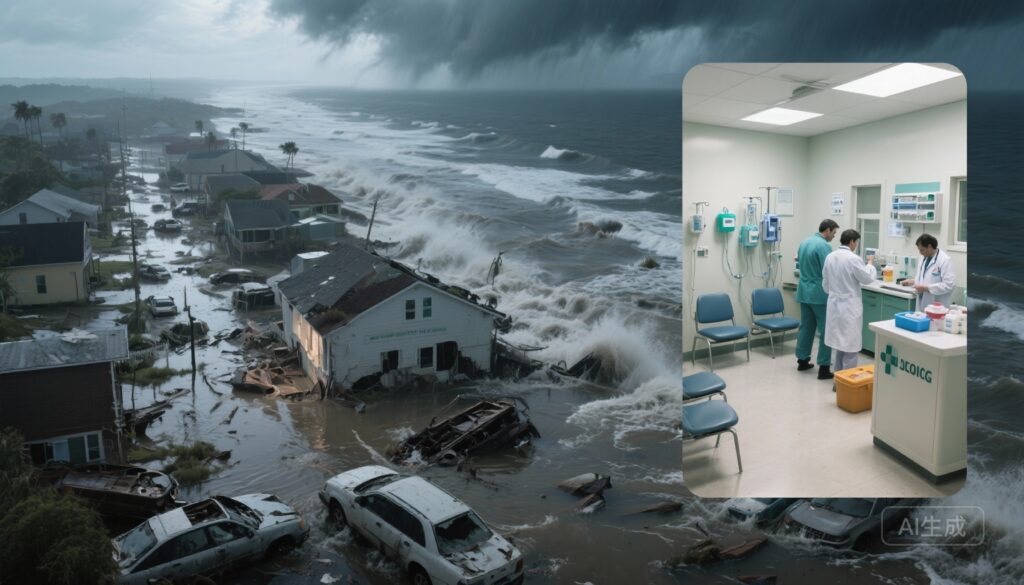Highlights
• Multinational evidence:
A two-stage time-series analysis of 217 tropical cyclone events and 14.8 million deaths (2000–2019) across nine countries/territories found consistent, short-term increases in cause-specific mortality after tropical cyclones.
• Highest and earliest risks:
Renal disease deaths showed the largest relative rise (cumulative RR 1.92 per additional cyclone day in the first two weeks), followed by injuries (RR 1.21). Most cause-specific risks peaked within the first two weeks after an event.
• Social and climatic modifiers:
Communities with higher deprivation and historically fewer cyclones experienced larger relative increases in mortality. Cyclone-related rainfall showed a consistent exposure–response relationship with mortality, particularly for respiratory, cardiovascular, and infectious causes.
Background
Tropical cyclones (including hurricanes and typhoons) are acute climate extremes that combine high winds, intense rainfall, storm surge and flooding. Beyond immediate trauma, they disrupt infrastructure, power, water, health services and medication supply chains — creating pathways to excess morbidity and mortality across many organ systems. With climate change projected to increase the intensity and precipitation of tropical cyclones, clinicians and health systems need robust, multi-country evidence describing which causes of death rise after these events, when excess risk is concentrated, and which populations are most vulnerable.
Study design and methods
The featured analysis by Huang et al. (BMJ 2025) is a two-stage, time-series study that pooled data from nine countries and territories spanning tropical, subtropical and extra-tropical settings: Australia, Brazil, Canada, South Korea, Mexico, New Zealand, the Philippines, Taiwan, and Thailand. The authors included all-cause mortality and cause-specific deaths (cardiovascular, respiratory, infectious, injuries, neuropsychiatric disorders, renal diseases, digestive diseases, diabetes, and neoplasms) during 2000–2019 and linked these to tropical cyclone exposure metrics for 217 cyclone events affecting communities represented in the mortality data.
Exposure quantification used a physics-based tropical cyclone field model to estimate local wind-speed and rainfall profiles, and the key exposure metric was ‘tropical cyclone day’ (and cumulative days), with distributed lag models examining short-term (up to several weeks) risk dynamics. Analyses accounted for temporal trends and used meta-analytic pooling across communities, with stratified analyses by deprivation and historical cyclone frequency to assess effect modification.
Key findings
The study included 14.8 million deaths and 217 tropical cyclone events. Main results were:
- Timing of excess mortality: Cause-specific mortality increases were concentrated in the first two weeks after cyclones, with risk rising rapidly after the event and declining thereafter.
- Magnitude by cause: During the first two weeks, each additional tropical cyclone day was associated with the following cumulative relative risks (RR) and 95% confidence intervals (CI):
- Renal diseases: RR 1.92 (95% CI 1.63–2.26)
- Injuries: RR 1.21 (95% CI 1.12–1.30)
- Diabetes: RR 1.15 (95% CI 1.08–1.21)
- Neuropsychiatric disorders: RR 1.12 (95% CI 1.05–1.19)
- Infectious diseases: RR 1.11 (95% CI 1.05–1.17)
- Digestive diseases: RR 1.06 (95% CI 1.02–1.09)
- Respiratory diseases: RR 1.04 (95% CI 1.00–1.08)
- Cardiovascular diseases: RR 1.02 (95% CI 1.01–1.04)
- Neoplasms: RR 1.02 (95% CI 1.00–1.04)
- Heterogeneity and vulnerability: Communities with greater socioeconomic deprivation and those with historically fewer tropical cyclones had substantially higher mortality risks following events — particularly for renal, infectious and digestive diseases, and diabetes-related deaths.
- Weather component effects: Rainfall associated with cyclones showed a more consistent increasing exposure–response relation with mortality risk than wind speed, especially for respiratory, cardiovascular and infectious disease deaths.
Clinical and public health interpretation of main findings
Renal disease showed the largest short-term relative increase in mortality. Mechanistic and operational explanations include: acute kidney injury (AKI) from dehydration or rhabdomyolysis after trauma; interruption of dialysis services (power loss, transport barriers, damage to facilities); and lapses in medication or monitoring for chronic kidney disease. The very high RR likely reflects both direct increases in organ-specific events and deaths from service disruptions that are mitigable with preparedness.
Injuries peaked early — consistent with drowning, blunt trauma and crush injuries during and immediately after storms. Increases in infectious and digestive disease deaths indicate post-flooding risks from contaminated water (leptospirosis, enteric infections), disrupted sanitation and overwhelmed primary care. Modest increases in cardiovascular and respiratory mortality are plausibly due to exacerbations (e.g., myocardial infarction, heart failure, COPD/asthma) precipitated by stress, environmental exposures (mold, particulate matter), and interruptions in chronic disease management.
Expert commentary: strengths, limitations and mechanistic insights
Strengths of the study include its large size, multinational scope, harmonized exposure modeling (wind and rainfall), and cause-specific analysis across many mortality categories. The use of distributed lag models allows the temporal pattern of risk to be characterized — critical for targeting response timelines.
Limitations to consider when applying the findings clinically or in policy include:
- Ecological/time-series design: associations are at the population level and cannot ascribe causality to individual deaths, though the temporal pattern strengthens plausibility.
- Exposure and outcome heterogeneity: death certification practices and coding vary across countries; exposure misclassification is possible despite physics-based modeling; local sheltering behaviors and evacuation policies differ.
- Residual confounding: simultaneous temperature extremes or concurrent infectious outbreaks could contribute to observed mortality changes.
- Generalizability: included countries are geographically diverse, but results may not extrapolate to all regions, especially small island states with different healthcare resilience profiles.
Mechanistically, the study confirms predictable pathways from disaster to death: direct trauma; interruption of time-sensitive lifesaving therapies (e.g., dialysis, insulin-dependent diabetes care, oxygen/ventilation, reperfusion for myocardial infarction); infectious disease transmission and waterborne illness; and mental health sequelae leading to neuropsychiatric mortality. The stronger rainfall–mortality signal emphasizes flood-control, water safety and sanitation as actionable priorities.
Implications for clinicians, health systems and policy
Clinicians should anticipate and proactively manage acute increases in need across several domains after cyclones. Practical measures include:
- Dialysis continuity planning: register patients, maintain emergency power, establish mobile or backup dialysis capacity and evacuation pathways.
- Chronic disease continuity: ensure medication caches, alternative dispensing sites, and telemedicine follow-up where possible for diabetes, cardiovascular and respiratory disease patients.
- Trauma and emergency surge readiness: equip emergency departments for mass-casualty and prolonged power outages; reinforce prehospital triage systems.
- Infection prevention after floods: strengthen water, sanitation and hygiene (WASH) interventions, early surveillance for leptospirosis and diarrheal illnesses, and rapid vaccination campaigns where appropriate.
- Targeted support to deprived and cyclone-naïve communities: prioritize investment in infrastructure resilience and community-level preparedness training.
At the health-systems level, integrating epidemiological evidence like this study into disaster planning can improve adaptive capacity: scenario-based exercises should include renal and chronic disease continuity, flood-specific risks, and equity-focused resource allocation.
Research gaps and next steps
Further work should refine individual-level risk estimates, evaluate interventions (e.g., mobile dialysis units, pre-positioned medication supplies), and quantify long-term post-disaster mortality and morbidity. Understanding why cyclone-naïve communities fare worse (behavioral preparedness, infrastructure deficits, risk perception) will inform targeted adaptation. Finally, linkage to climate projections is needed to model future healthcare burden under warming scenarios.
Conclusion
This large, multisite time-series study demonstrates that tropical cyclones produce short-term increases in mortality across multiple causes, with the largest relative effects for renal disease and injuries, and meaningful rises for infectious, metabolic and neuropsychiatric causes. Vulnerable communities — socioeconomically deprived or historically unexposed to cyclones — experience substantially higher relative risks. The consistent association with cyclone-related rainfall highlights flood-mitigation, water safety and infrastructure resilience as crucial mitigation targets. Health systems need to incorporate these multisystem risks into disaster preparedness and response, with special emphasis on maintaining continuity of care for dialysis-dependent and chronically ill populations.
Funding and trial registration
Funding details are reported in the original paper: Huang W, Xu R, et al., BMJ 2025. No clinical trial registration applies for this observational time-series analysis.
Selected references
1. Huang W, Xu R, Yang Z, Otto C, Hales S, Hundessa S, et al. Cause specific mortality risks associated with tropical cyclones in multiple countries and territories: two stage, time series study. BMJ. 2025 Nov 5;391:e084906. doi: 10.1136/bmj-2025-084906.
2. Kishore N, Marqués D, Mahmud A, et al. Mortality in Puerto Rico after Hurricane Maria. N Engl J Med. 2018;379:162–170.
3. IPCC. Climate Change 2021: The Physical Science Basis. Contribution of Working Group I to the Sixth Assessment Report of the Intergovernmental Panel on Climate Change. Cambridge University Press; 2021.
4. Noji EK. The public health consequences of disasters. Prehospital Disaster Med. 2000;15(4):147–157.
Article provenance and peer review
This article is a clinical-scientific interpretation of peer-reviewed epidemiological findings intended for clinicians, health planners and policy makers. It synthesizes results and translates them into actionable recommendations while noting limitations inherent to ecological time-series analyses.


